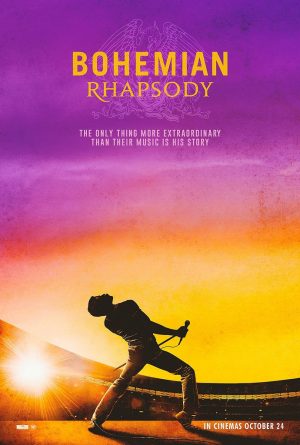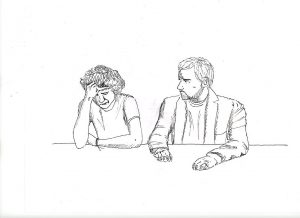Separating art from the artist sets a dangerous precedent
February 6, 2019
There is no trope more common in Hollywood than an acclaimed artist whose questionable past threatens their career, and with the rise of #MeToo, this phenomenon is more prevalent than ever. Bloomberg reports that over 425 prominent people across industries have been accused of sexual misconduct since the movement began.
Unfortunately, just as common are calls by loyal fans to “separate art from the artist.” R&B singer R. Kelly is the latest celebrity to exemplify this dangerous trend. Earlier this month, Lifetime released “Surviving R. Kelly,” a new docuseries exposing over 25 years of shocking behavior, from child pornography, rape and predatory behavior to his secret marriage at 27 years old to late R&B superstar Aaliyah, at the time only 15.
However, the public has far from disavowed Kelly; on the contrary, ABC News finds that his streams doubled after the docuseries’ release. Supporters of his music argue that an artist’s moral character does not influence the merit of their art. “R. Kelly may be a terrible person,” they say, “but ‘Ignition’ is a great song.” Unfortunately, this argument falls flat in light of the power dynamics that contribute to sexual assault, and only serves to sweep victims under the rug.
Separating art from the artist ignores the role that art plays as a tool of abuse. At its most basic level, sexual assault is rooted in power dynamics. The rich and famous are able to offer opportunities, like mentorship and a chance at stardom, to would-be victims, but this power can also be used to punish anyone they see fit. They become predators by holding incentives in one hand and threats in the other, creating an environment where victims are scared to resist.
Bill Cosby lured women into his hotel room under the guise of career mentorship, only to drug and assault them; Harvey Weinstein threatened to blacklist actresses unless they performed sexual favors; R. Kelly guided young girls’ music careers, only for it to turn into something much more sinister. It is for this reason that art cannot be insulated from its creator. The influence art yields creates the perfect storm for abuse. Partaking in that art, even after misconduct comes to light, is an implicit endorsement of it.
Fans argue that art should solely be judged on its merits, but this is a gross oversimplification. All art is influenced by the life of its creator; it’s what makes art unique to begin with. Haven’t we all heard a musician say they poured their heart and soul into an album, or an actor say they drew on their personal experiences to play a role? In reality, the lines between art and the artist are much more blurred.
In many cases, the disturbing behavior exhibited by public figures is mirrored in their work. It’s no coincidence that Woody Allen, accused of molesting and eventually marrying his stepdaughter, often directed films depicting older men interested in younger women, or that in the same year that R. Kelly married 15-year-old Aaliyah, he wrote and produced her debut album, “Age Ain’t Nothing But a Number.”
It’s naive to assume that art and the artist can be separated, especially when the art creates a situation ripe for misconduct and even the artists themselves don’t draw that distinction.
Furthermore, endorsing this art even after allegations come to light legitimizes continued abuse. In fact, while the newest allegations against R. Kelly are horrifying, they are not surprising by any means. Kelly settled two allegations of statutory rape in 1998 and 2001 out of court. In 2002, a video surfaced showing Kelly having sex with an underage girl, leading to a police raid on his home that uncovered more child pornography.
In spite of this, Kelly released five platinum albums and 26 top 40 singles in the years afterward. As to how a sexual predator can simultaneously be considered the greatest R&B artist of all time, the explanation is clear: millions of fans decided that their preference for his music was more important than his dehumanization of women and girls.
This sends a clear message to famous figures that they can continue abusing their power, and to victims that they don’t matter. Listening to these artists is never just about music; it’s about a conscious erasure of their victims’ stories. When this behavior isn’t seen as career-ending, it is seen as acceptable.
Some might argue that a single stream isn’t significant in the big picture, when artists have millions of listeners. However, when millions of fans individually decide that withdrawing their support for a celebrity is unimportant, there is a large collective impact. The mindset that one person’s actions don’t matter justifies nearly every immoral action, or the absence of any moral action — after all, it’s just one person, right?
However, like all things, rejecting work by artists with checkered pasts is not entirely cut and dry. Disavowing R. Kelly raises the question of whether the artists and music executives he worked with should be also be punished for their potential knowledge of his crimes. These questions of culpability are vague and merit further discussion.
Regardless, it is clear that art and the artist cannot be separated. Endorsing artists who use their fame to exploit others is not only insulting to their victims, but it sets a dangerous precedent. Previous accusations against figures like R. Kelly have failed to hold them accountable — now we must do better. No song is worth the entrenchment of rape culture and the dehumanization of society’s most vulnerable.




